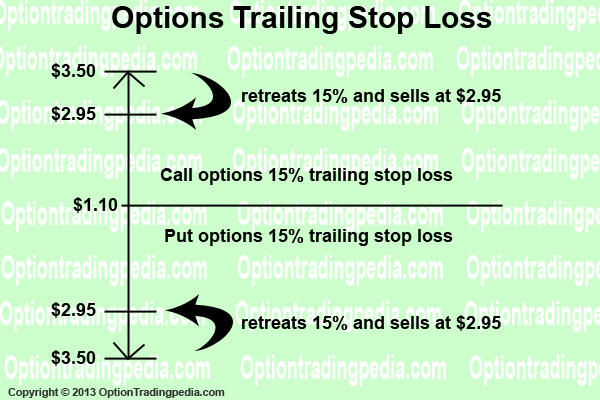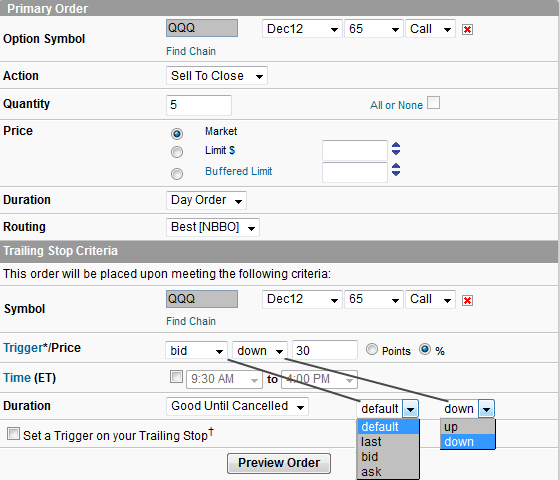What is a Trailing stop loss order in options trading and how could it help me extend my profitability?
Options Expiration Day - Definition
Options Expiration Day is the when options contracts expiring on that day becomes void and beyond which day will cease to exist.
Trailing Stop Loss - Introduction
Trailing stop loss is an advanced options order that automatically tracks the prices of your options positions and then sell them automatically when their value decline by a predetermined amount from the highest price achieved. Even though it is known as a "Trailing Stop Loss", it is used not only as a stop loss method but also a profit taking method by most options trading professionals.
How Does Trailing Stop Loss Work?
Trailing stop loss is an advanced options order where your options broker system automatically tracks the continuously changing prices of your options and then triggers a market order to sell when those prices retreat a predetermined amount from the highest price achieved. This saves the options trader from having to monitor the prices whole day long in order to achieve the same outcome.
Trailing Stop Loss ExampleAssuming QQQ is trading at $65. Through technical analysis, John came to the conclusion that QQQ is going to make a quick run upwards and wished to profit from this rally using QQQ Call Options. John bought 1 contract of its $65 strike price call options for $1.10. John intends to let the profits run on this position and sell the position when the options price peaks out and retreats by 15%. In order to do this without having to watch the market whole day long, John set a 15% trailing stop loss on the position. |

What Is Trailing Stop Loss Used For?
Even though this type of advanced order is known as a "Trailing Stop Loss", it is actually more commonly used as a form of automatic profit taking rather than a stop loss. It is used by most professional options traders to allow an option's profit to run and then sell automatically when the rally runs out of steam generally by a retreat in the price of the option as outlined by the example in the previous section. Of course, a trailing stop loss put on the very moment the position is bought does work as a stop loss.
Trailing Stop Loss ExampleAssuming QQQ is trading at $65. Through technical analysis, John came to the conclusion that QQQ is going to make a quick run upwards and wished to profit from this rally using QQQ Call Options. John bought 1 contract of its $65 strike price call options for $1.10. QQQ unfortunately didn't perform as expected and started going downwards after John bought his call options. John's call options are automatically sold through the trailing stop loss order when it retreated more than 30% at $0.75. |
How To Use Trailing Stop Loss?
Trailing Stop Loss consist of two parts; The Primary Trade and the Trailing Stop Criteria. The primary trade is simply the trade you wish to perform and the trailing stop criteria states the condition under which the primary trade is to be executed.

The trailing stop loss criteria can be based on actual dollar & cents (points) or a percentage move. The example above shows you the order form that John in the previous example used. The most common criteria used for trailing stop loss is "Bid" "Down" "%" for selling a long options position on a pull back in price (Why use bid price instead of Default in this case? Read more about the Market Price of Options). This trailing stop loss order instructs the options broker to sell the call options when the bid price of these call options retreat 30% from the highest price achieved after putting on the order.
A trigger can also be added to the order so that the trailing stop loss order only start when the price of the underlying stock or the option itself exceeds a certain level.
Using Trailing Stop Loss For Short Positions
Trailing stop loss can also be used for closing off short options positions like a Naked Call Write or a Naked Put Write. When closing out a short position, you need to buy to close the position on the ask price and would want to do so when the price of the option appreciates. As such, a trailing stop loss order on a short options position would typically use the "Ask", "Up", "%" criteria.
Trailing Stop Loss On Short Options Position ExampleAssuming QQQ is trading at $65. Through technical analysis, John came to the conclusion that QQQ is going to make a moderate move upwards (read about the Six Outlooks In Options Trading) and wished to profit from this small rally by writing QQQ put options. John wrote 1 contract of its $65 strike price put options for $1.00. John wants to stop loss if the position gains 30% and therefore set a 30% trailing stop loss on the position triggered on the "Ask" price going "Up" by "30%". QQQ unfortunately didn't perform as expected and started going downwards. John's put options are automatically closed out through the trailing stop loss order when they appreciated from $1.00 to $1.30, making a loss of $0.30. |
Disadvantage of Trailing Stop Loss
So, are there disadvantages to using Trailing Stop Loss? Yes, the biggest disadvantage of Trailing Stop Loss in options trading is actually its biggest advantage; automation that prevents involvement of human emotions or hesitation at the moment of execution. This can lead to positions being "swung out of position" from big intraday whipsaws that sometimes happen without warning. Such whipsaws (sometimes known as "Price Glitch") may be temporary and may sometimes last only a few seconds before the price of the underlying stock or option go back to their previous levels and can be easily detected and avoided by a human trader. However, such a whipsaw is sometimes enough for the trailing stop loss order to trigger and close off your position, sometimes for an unnecessary loss.
Important Disclaimer : Options involve risk and are not suitable for all investors. Data and information is provided for informational purposes only, and is not intended for trading purposes. Neither www.optiontradingpedia.com, mastersoequity.com nor any of its data or content providers shall be liable for any errors, omissions, or delays in the content, or for any actions taken in reliance thereon. Data is deemed accurate but is not warranted or guaranteed. optiontradinpedia.com and mastersoequity.com are not a registered broker-dealer and does not endorse or recommend the services of any brokerage company. The brokerage company you select is solely responsible for its services to you. By accessing, viewing, or using this site in any way, you agree to be bound by the above conditions and disclaimers found on this site.
Copyright Warning : All contents and information presented here in www.optiontradingpedia.com are property of www.Optiontradingpedia.com and are not to be copied, redistributed or downloaded in any ways unless in accordance with our quoting policy. We have a comprehensive system to detect plagiarism and will take legal action against any individuals, websites or companies involved. We Take Our Copyright VERY Seriously!
Site Authored by